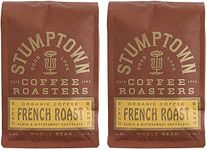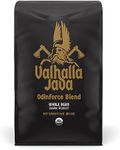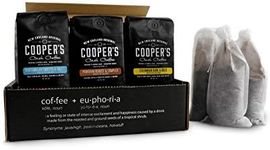Buying Guide for the Best Organic Coffee Beans
Choosing the right organic coffee beans can greatly enhance your coffee-drinking experience. Organic coffee beans are grown without synthetic fertilizers or pesticides, which can result in a cleaner, more natural taste. When selecting organic coffee beans, it's important to consider several key specifications to ensure you get the best fit for your taste preferences and brewing methods. Here are the key specs to consider and how to navigate them.OriginThe origin of coffee beans refers to the geographical location where the beans were grown. This is important because the climate, soil, and altitude of the region can significantly influence the flavor profile of the coffee. For example, beans from Ethiopia often have fruity and floral notes, while beans from Colombia might have a more balanced and nutty flavor. To pick the right origin for you, consider what flavor profiles you enjoy. If you like bright and fruity flavors, look for beans from African countries. If you prefer a more balanced and smooth taste, beans from Latin America might be a better fit.
Roast LevelRoast level indicates how long and at what temperature the coffee beans were roasted. This is crucial because it affects the flavor, aroma, and body of the coffee. Light roasts are typically more acidic and retain more of the beans' original flavors, making them ideal for those who enjoy a more complex and nuanced cup. Medium roasts offer a balance between acidity and body, providing a well-rounded flavor. Dark roasts have a bolder, more robust flavor with less acidity, which can be perfect for those who prefer a strong, rich coffee. Choose a roast level based on your taste preference and how you plan to brew your coffee.
Bean TypeThere are two main types of coffee beans: Arabica and Robusta. Arabica beans are known for their smooth, mild flavor and lower caffeine content, making them a popular choice for specialty coffees. Robusta beans have a stronger, more bitter taste and higher caffeine content, which can be ideal for espresso blends. If you enjoy a smooth, flavorful cup of coffee, Arabica beans are likely the best choice. If you prefer a stronger, more intense coffee, consider Robusta beans or a blend of both.
Processing MethodThe processing method refers to how the coffee cherries are processed after harvesting. This can impact the flavor and quality of the beans. The three main methods are washed, natural, and honey. Washed (or wet) processing removes the fruit before drying, resulting in a cleaner, brighter flavor. Natural (or dry) processing dries the whole cherry, giving the coffee a fruity and complex taste. Honey processing is a hybrid method that leaves some of the fruit on the bean, offering a balance of sweetness and acidity. Choose a processing method based on the flavor profile you prefer.
FreshnessFreshness is a key factor in the quality of your coffee. Coffee beans start to lose their flavor and aroma shortly after roasting. To ensure you get the best taste, look for beans that have been roasted recently. Many coffee bags will have a roast date printed on them. Ideally, you should use the beans within a few weeks of the roast date. If you want the freshest coffee possible, consider buying from local roasters or those who roast to order.
CertificationsCertifications can provide assurance about the quality and ethical standards of the coffee. Common certifications include USDA Organic, Fair Trade, and Rainforest Alliance. USDA Organic ensures the coffee is grown without synthetic chemicals. Fair Trade certification indicates that the farmers were paid a fair price for their beans, promoting sustainable livelihoods. Rainforest Alliance certification focuses on environmental and social sustainability. Choose certifications that align with your values and priorities.






















